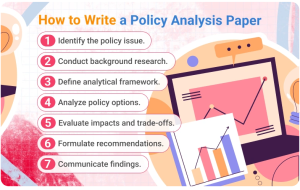How to Structure a Policy Analysis Paper
A policy analysis paper format demands organizing your content coherently and logically to effectively communicate your analysis and findings. Here’s a typical structure you can follow:

Introduction
Provide an overview of the issue or problem you’re analyzing.
Clearly state the purpose of your analysis.
Introduce the policy or policies under review.
Provide background information to contextualize the issue.
State your thesis or research question.
Policy Context and Background
Provide more in-depth background information on the issue.
Describe the historical development of the policies.
Discuss the context in which the procedure was implemented.
Identify key stakeholders and their interests in the strategy.
Policy Analysis Framework
Explain the framework or methodology you’re using to analyze the policy.
Define key concepts and terms relevant to your analysis.
Discuss any theoretical frameworks or models guiding your analysis.
Outline the criteria or criteria you will use to evaluate the procedure’s effectiveness.
Policy Goals and Objectives
Identify and discuss the stated goals and objectives of the policy.
Evaluate the clarity and coherence of these goals.
Discuss any potential conflicts or contradictions among the goals.
Policy Implementation
Describe how the policy has been implemented in practice.
Discuss any challenges or barriers to implementation.
Evaluate the effectiveness of implementation strategies.
Policy Outcomes and Impacts
Assess the outcomes and impacts of the policy.
Evaluate the extent to which the procedure has achieved its intended goals.
Discuss any unintended consequences or side effects of the approach.
Policy Alternatives
Identify and discuss alternative policy options or approaches.
Evaluate the strengths and weaknesses of each alternative.
Discuss the potential trade-offs associated with each alternative.
Recommendations
Based on your analysis, provide recommendations for policymakers.
Discuss specific actions or changes that could improve the process.
Justify your recommendations with evidence from your analysis.
Conclusion
Summarize the main findings of your analysis.
Restate your thesis or research question.
Reflect on the broader implications of your analysis.
Discuss any limitations or areas for further research.
References
Provide a list of sources cited in your paper.
Follow the appropriate citation style (e.g., APA, MLA, Chicago).
Need help with the assignment at this stage? Hire writer for political essay help to save time and secure optimal academic results.
Source:
